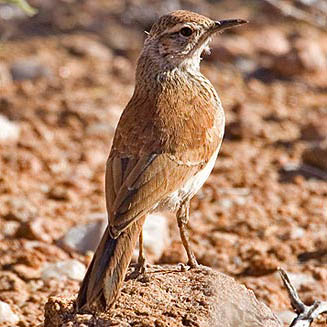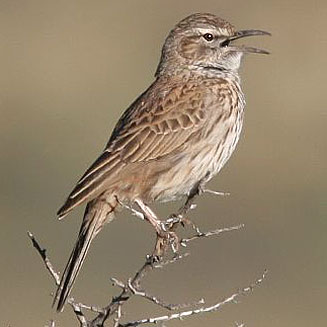|
Certhilauda subcoronata (Karoo Long-billed lark)
Karoolangbeklewerik [Afrikaans]; Cotovia-de-bico-comprido-oriental
[Portuguese]
Life
> Eukaryotes >
Opisthokonta
> Metazoa (animals) >
Bilateria >
Deuterostomia > Chordata >
Craniata > Vertebrata (vertebrates) > Gnathostomata (jawed
vertebrates) > Teleostomi (teleost fish) > Osteichthyes (bony fish) > Class:
Sarcopterygii (lobe-finned
fish) > Stegocephalia (terrestrial
vertebrates) > Tetrapoda
(four-legged vertebrates) > Reptiliomorpha > Amniota >
Reptilia (reptiles) >
Romeriida > Diapsida > Archosauromorpha > Archosauria >
Dinosauria
(dinosaurs) > Saurischia > Theropoda (bipedal predatory dinosaurs) >
Coelurosauria > Maniraptora > Aves
(birds) > Order: Passeriformes
> Family: Alaudidae
> Genus: Certhilauda
 |
 |
|
Karoo long-billed lark. [photo
Neil Gray
©] |
Karoo long-billed lark, Karoo National Park, South
Africa. [photo Trevor Hardaker ©] |
Distribution and habitat
Endemic to southern Africa, occurring from central Namibia
though to the Northern Cape, Western Cape and the Free State Province. It
generally prefers semi-arid dwarf shrubland (such as Karoo) and grassy shrubland
on boulder-strewn plains and rocky ridges.
Food
It mainly eats insects supplemented with seeds, plucking
food items from beneath stones and the bases of plants. It is a pest for
farmers, as it sometimes digs up planted grains. The following food items have been recorded
in its diet:
- Insects
- Arachnids
- Seeds of shrubs
- Augea capensis
- Hermannia
- Limeum
- Osteospermum
- Fruit and seeds
- Atriplex semibaccata (Australian saltbrush)
- Lycium (honey-thorns)
Breeding
- The nest is cup built of roots and twigs and lined with the fluffy seeds
of the Karoo rosemary (Eriocephalus). It is typically placed in a
shallow excavated hollow at the base of a shrub or stone.
- It lays 2-3 eggs, usually in the months from August-April.
- The chicks are fed by both parents, becoming independent several weeks
after leaving the nest.
Threats
Not threatened, in fact it is the most common long-billed
lark species.
References
-
Hockey PAR, Dean WRJ and Ryan PG 2005. Roberts
- Birds of southern Africa, VIIth ed. The Trustees of the John Voelcker
Bird Book Fund, Cape Town.
|
